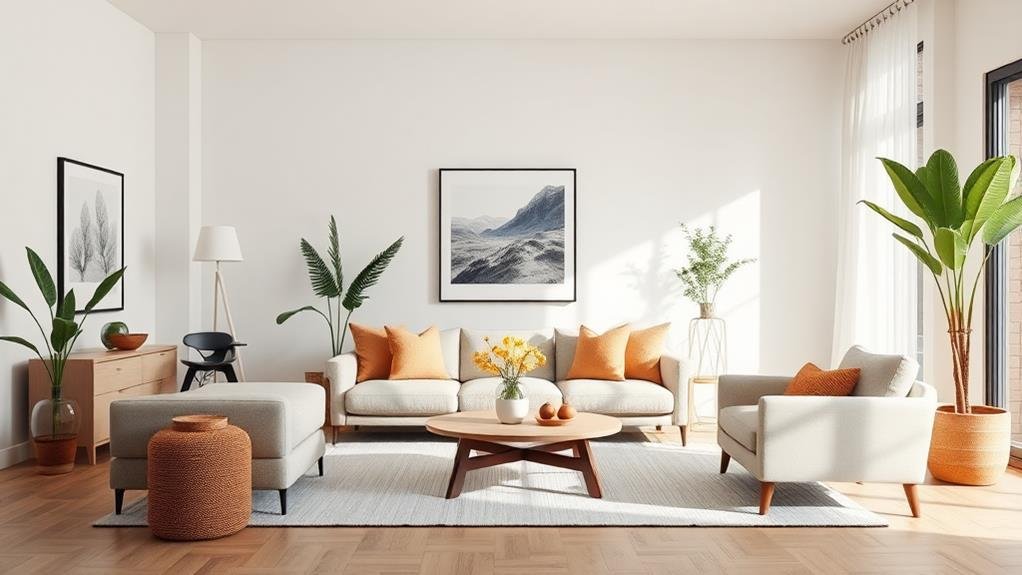Embark on an enchanting journey into the realm of interior design, where creativity intertwines with functionality to craft spaces that mirror your personality and taste. Discover the art of spatial awareness, color psychology, and harmony principles to create a cohesive design narrative. Dive into the world of furniture selection, lighting techniques, and texture incorporation to elevate your space with elegance and depth. From maximizing storage solutions to mixing modern and traditional styles, each element intertwines to form a symphony of style. Uncover the secrets of sustainable design practices and the art of styling, where details and trends converge to bring beauty to your interiors.
Key Takeaways
- Utilize spatial awareness for optimal functionality and aesthetics.
- Incorporate color psychology to evoke emotions and set the room's tone.
- Ensure furniture selection and arrangement harmonize with the overall design scheme.
- Layer lighting techniques for a well-rounded ambiance.
- Balance textures and patterns for visual interest and harmony.
Understanding Interior Design Principles
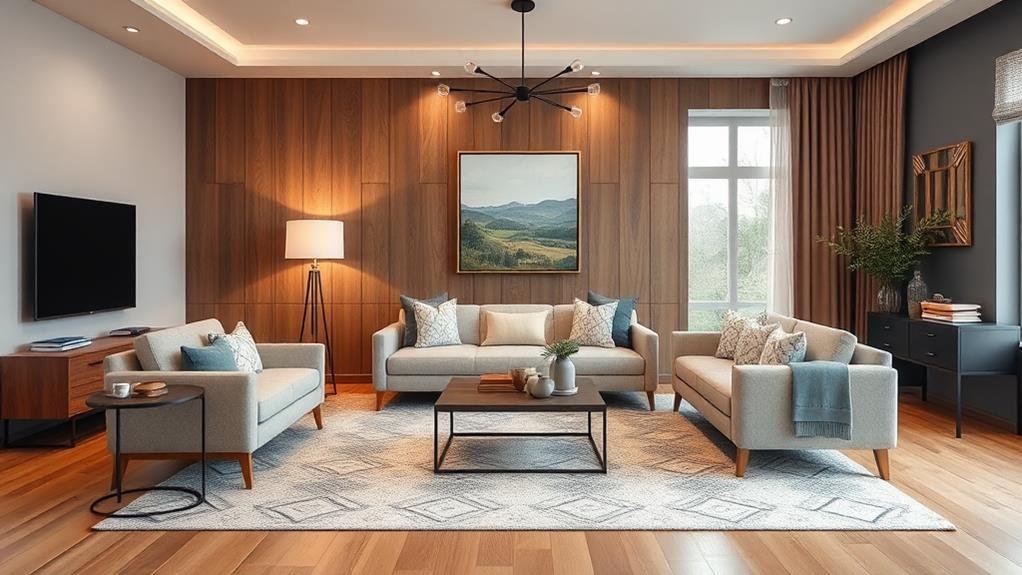
To truly master interior design, you must first grasp the fundamental principles that guide the creation of captivating spaces.
Design fundamentals encompass spatial awareness, which involves understanding how to utilize space effectively to enhance functionality and aesthetics. Color psychology plays a crucial role in evoking emotions and setting the tone of a room, while harmony principles ensure that all design elements work cohesively together.
Scale proportions are key in maintaining balance and avoiding overpowering or underwhelming elements within a space. Focal points draw the eye and create visual interest, guiding the viewer through the room with strategically placed design elements.
Flow dynamics dictate how individuals move within a space, emphasizing the importance of creating a seamless and intuitive layout. Aesthetic coherence is achieved by considering cultural influences that can impact design choices, ensuring a space tells a cohesive story.
Choosing the Right Color Palette
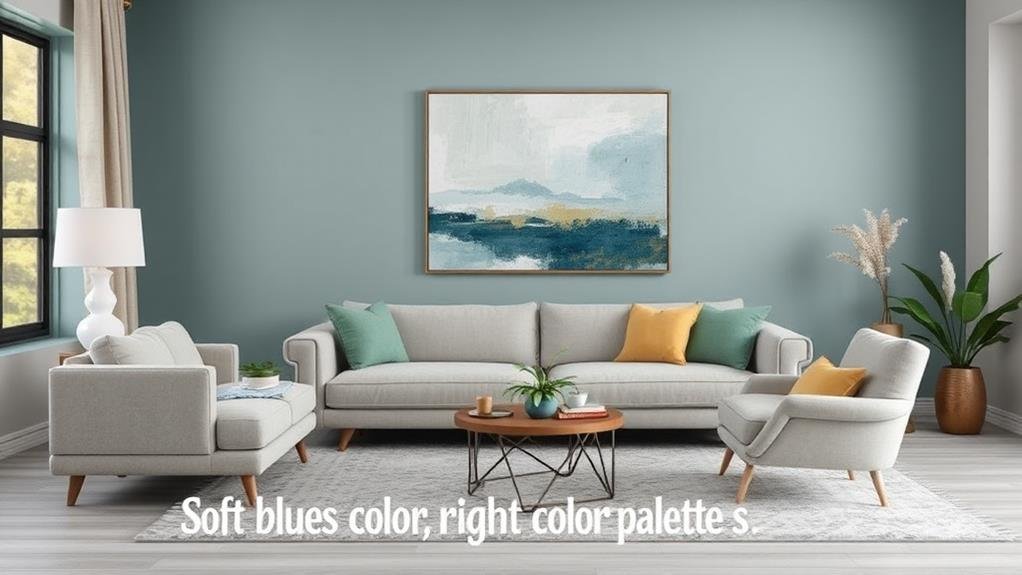
Exploring the world of interior design opens up a realm of possibilities, with one of the key elements being the selection of the perfect color palette. When choosing colors for your space, consider the principles of color psychology and current seasonal trends to create a harmonious and stylish environment.
In color psychology, hues like soft blues and greens can promote calmness and tranquility, ideal for bedrooms or reading nooks. On the other hand, vibrant yellows and oranges can inject energy and warmth into social spaces like living rooms or dining areas.
Consider incorporating seasonal trends into your color choices. For example, during winter, deep burgundies and forest greens can evoke a cozy atmosphere, while pastel pinks and blues in spring can bring a sense of renewal and freshness. Embrace the spirit of each season with your color palette to reflect the changing world outside.
| Tranquil and Calming | Energetic and Warm |
|---|---|
| Soft Blues and Greens | Vibrant Yellows and Oranges |
| Pastel Pinks and Blues (Spring) | Deep Burgundies and Forest Greens (Winter) |
Selecting Furniture That Fits
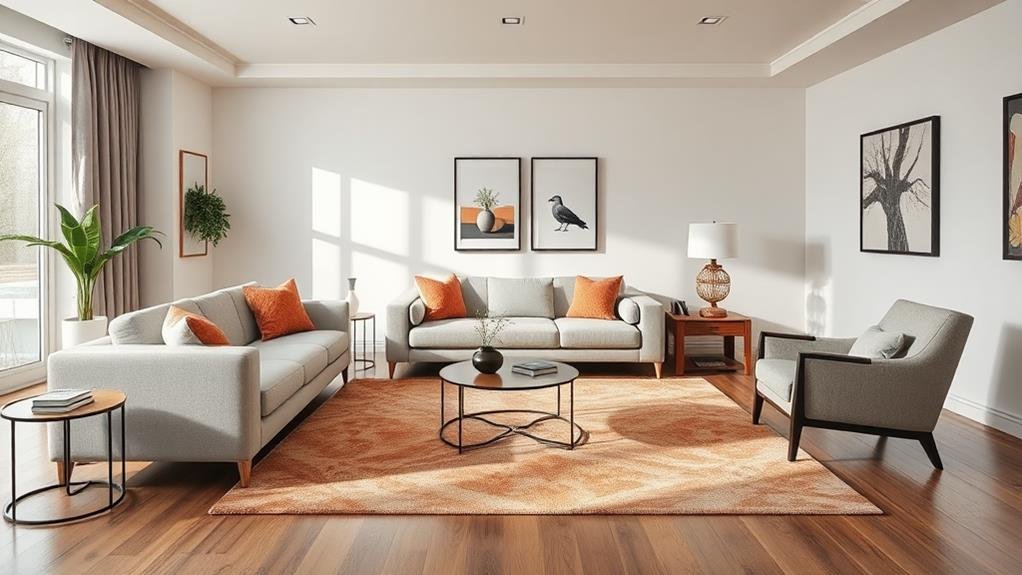
In the realm of interior design, the careful selection of furniture plays a crucial role in shaping the functionality and aesthetics of a space. When choosing furniture, consider the scale to ensure pieces complement the size of the room without overwhelming it.
Opt for materials that not only align with your style preferences but also offer durability and easy maintenance. Create cohesion by selecting furniture that harmonizes in style with the overall design scheme.
Factor in your budget while exploring options that balance quality and cost-effectiveness. Prioritize comfort by choosing pieces that invite relaxation and provide ergonomic support.
Opt for multifunctional furniture to maximize space optimization and cater to diverse needs. Stay aware of current trends to infuse modern elements into your design while staying true to your personal style.
Ultimately, the selection of furniture should blend seamlessly with the space, enhancing both its functionality and visual appeal.
Utilizing Lighting for Ambiance
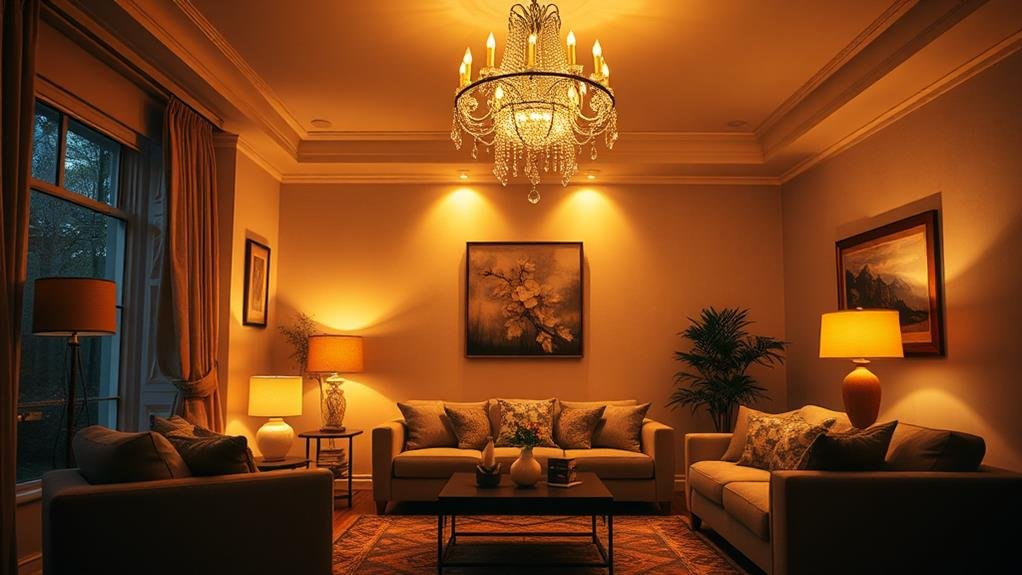
When creating a harmonious interior space, mastering the art of lighting is key to setting the right ambiance. Think of lighting as the soul of your design, capable of transforming a room's mood with just the flick of a switch.
To achieve a well-rounded ambiance, consider implementing layered lighting techniques. Start with ambient brightness through general illumination like overhead lights or recessed fixtures that evenly spread light throughout the room.
Then, add task lighting for specific areas like reading nooks or kitchen counters. Accent lighting can highlight art pieces or architectural features, adding depth and drama to your space.
Experiment with different types of lighting fixtures, such as pendants, sconces, and floor lamps, to create varying levels of illumination. Dimmer switches are also essential in controlling the intensity of light to suit different occasions.
Don't forget the power of natural light; maximize it with strategically placed mirrors or sheer curtains. By skillfully using layered lighting, you can sculpt a space that not only looks beautiful but feels inviting and comfortable.
Incorporating Textures and Patterns
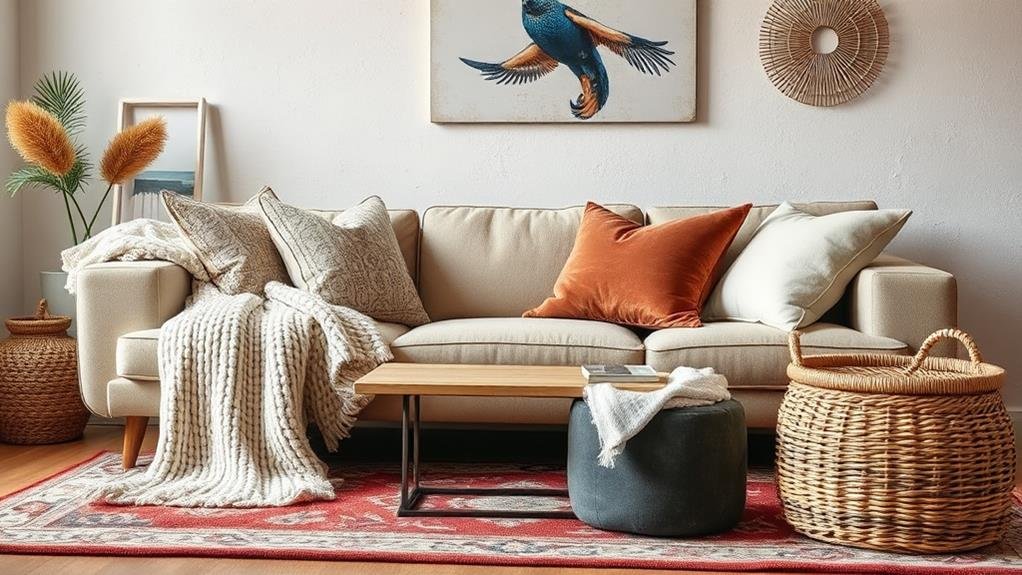
Get ready to elevate your interior space by mastering the art of incorporating textures and patterns.
Textures aren't just tactile but also visually stimulating, adding depth and character to your design.
On the other hand, patterns inject a sense of movement and energy, creating focal points and sparking visual interest.
Mastering the balance between textures and patterns will result in a harmonious space that exudes sophistication and style.
Textures Enhance Visual Appeal
Stirring depth into a space goes beyond just colors and furniture arrangements.
Textures play a vital role in creating a visually appealing interior that captivates your senses. Embrace a variety of textures to elevate your design game:
- Textural Contrasts: Play with smooth and rough surfaces to add interest and dimension.
- Tactile Experiences: Incorporate materials that invite touch and feel luxurious under your fingertips.
- Layered Materials: Mix different textures like wood, metal, and fabric to create a dynamic look.
- Natural Elements: Integrate elements like stone, wood, or plants to bring the outdoors inside.
Patterns Add Dynamic Interest
To truly elevate your interior design game, consider the dynamic interest that patterns add to a space. Bold patterns can make a statement, while geometric designs bring a sense of order. Playful motifs inject personality, and contrasting prints create visual intrigue.
Layered patterns offer depth, vintage styles evoke nostalgia, and nature-inspired patterns bring the outdoors in. Experiment with color blocking for a modern twist, embrace abstract designs for a contemporary feel, and incorporate cultural influences for a touch of global sophistication.
Mixing and matching these diverse patterns can create a harmonious yet visually stimulating environment. Consider using a large, bold pattern as the focal point, and then complement it with smaller, intricate designs to add interest without overwhelming the space.
Remember to balance the intensity of the patterns with solid colors to prevent a chaotic look. Whether you prefer a cohesive theme or a more eclectic mix, patterns offer a versatile way to express your unique style and create a space that's as vibrant and dynamic as you are.
Balancing Textures and Patterns
Achieving a harmonious blend of textures and patterns is key to creating a visually captivating and inviting interior space.
When it comes to balancing textures and patterns in interior design, you want to ensure that each element complements the other, creating a cohesive and appealing environment.
Here are some tips to help you master this art:
- Contrast Techniques: Experiment with combining different textures and patterns to create visual interest.
- Layering Fabrics: Use various fabrics like silk, wool, and cotton to add depth and richness to your space.
- Tactile Contrasts: Incorporate textures that not only look good but also feel different to touch, adding a sensory experience to your design.
- Visual Harmony: Aim to create a balance between bold patterns and subtle textures to maintain visual appeal without overwhelming the space.
Creating Functional Layouts
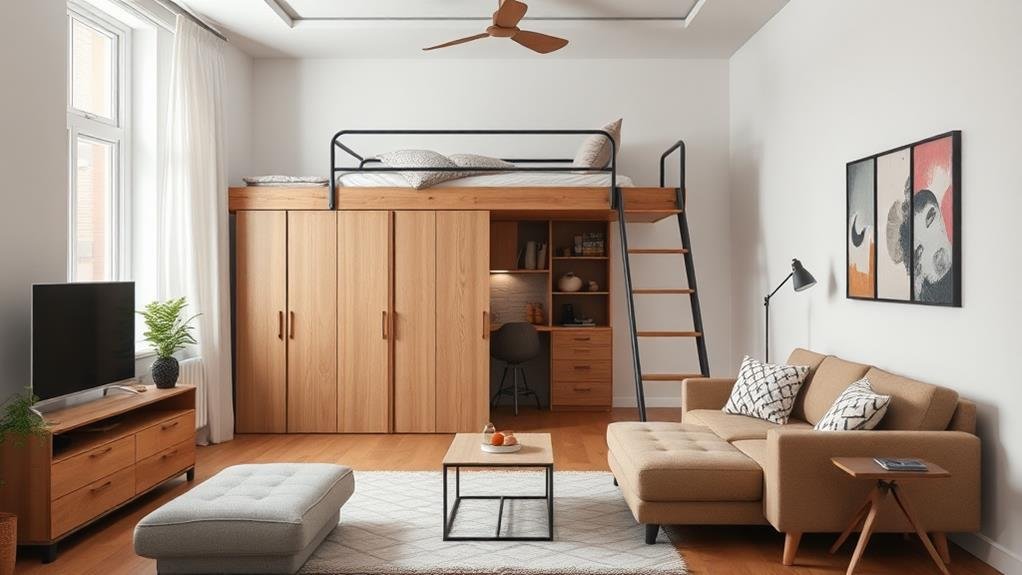
Crafting a well-thought-out layout in interior design is akin to composing a symphony of spatial harmony. When designing interiors, consider essential factors like space planning, traffic flow, and user needs to ensure a functional and aesthetically pleasing layout. Incorporating zoning techniques can help create multifunctional areas that cater to various activities seamlessly. Furniture arrangement plays a crucial role in defining the purpose of each space, so keep room dimensions in mind to avoid overcrowding. Accessibility considerations are key for ensuring that the layout is convenient for everyone.
To emphasize the importance of ergonomic design, here is a breakdown of key aspects to consider in creating functional layouts:
| Space Planning | Traffic Flow | Furniture Arrangement | Accessibility Considerations |
|---|---|---|---|
| Utilize space efficiently for optimal use | Ensure easy movement throughout the space | Place furniture for comfort and functionality | Consider needs of individuals with mobility challenges |
Adding Personalized Touches
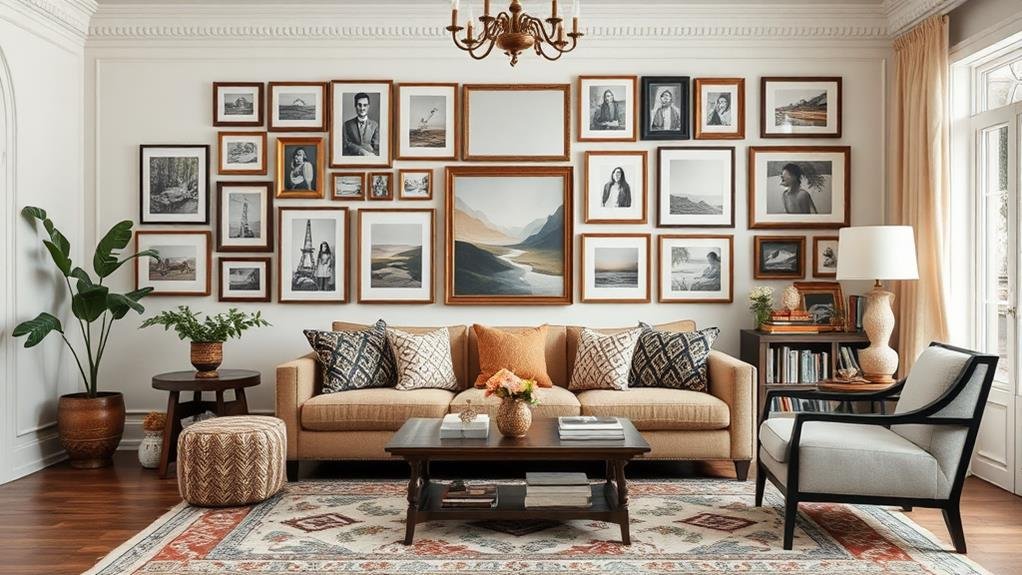
Enhancing a space with personalized touches is like adding strokes of a painter's brush to create a masterpiece. Infusing your home with unique elements that reflect your personality can truly elevate the ambiance.
Here are some ideas to help you bring your personal touch into your living space:
- Display Personalized Art: Hang up pieces that speak to you, whether they're creations of your own or works from local artists.
- Incorporate Sentimental Pieces: Showcase items that hold emotional value, such as a trinket passed down through generations.
- Create DIY Projects: Channel your creativity into crafting handmade items that add a personal touch to your decor.
- Curate Themed Collections: Showcase your interests by displaying collections that reflect your passions, like vintage cameras or antique books.
Maximizing Storage Solutions
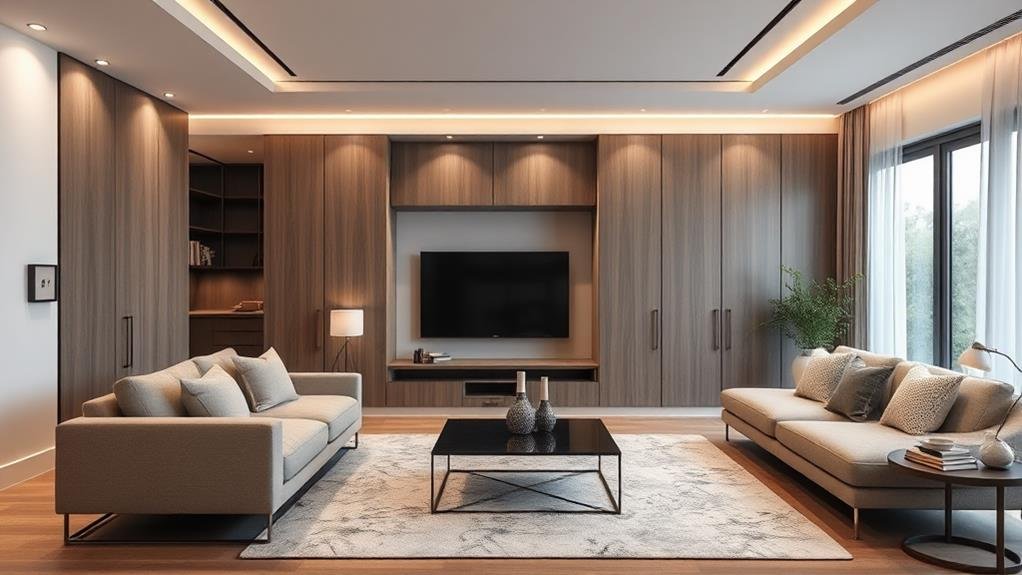
Infusing your living space with personalized touches not only adds character but also serves a functional purpose. When it comes to maximizing storage solutions, incorporating hidden storage and multi-functional furniture can help maintain a clutter-free environment while enhancing the aesthetic appeal of your home.
To efficiently utilize your space, consider integrating furniture pieces that serve dual purposes, such as ottomans with hidden compartments or coffee tables with built-in storage. Additionally, wall-mounted shelves and cabinets can provide both decor and functionality, allowing you to display cherished items while keeping the area organized.
Below is a table showcasing some innovative storage solutions for your consideration:
| Storage Solution | Description | Benefits |
|---|---|---|
| Ottoman with Hidden Compartment | Stylish seating that doubles as a storage unit | Conceals items within easy reach |
| Wall-Mounted Shelves | Display decor while storing items | Maximizes vertical space |
| Multi-Functional Bed | Beds with drawers or lift-up storage | Utilizes space efficiently |
| Storage Bench | Provides seating and hidden storage | Perfect for entryways or bedrooms |
Implementing these hidden storage and multi-functional furniture ideas can help you create a harmonious and organized living space.
Enhancing Small Spaces
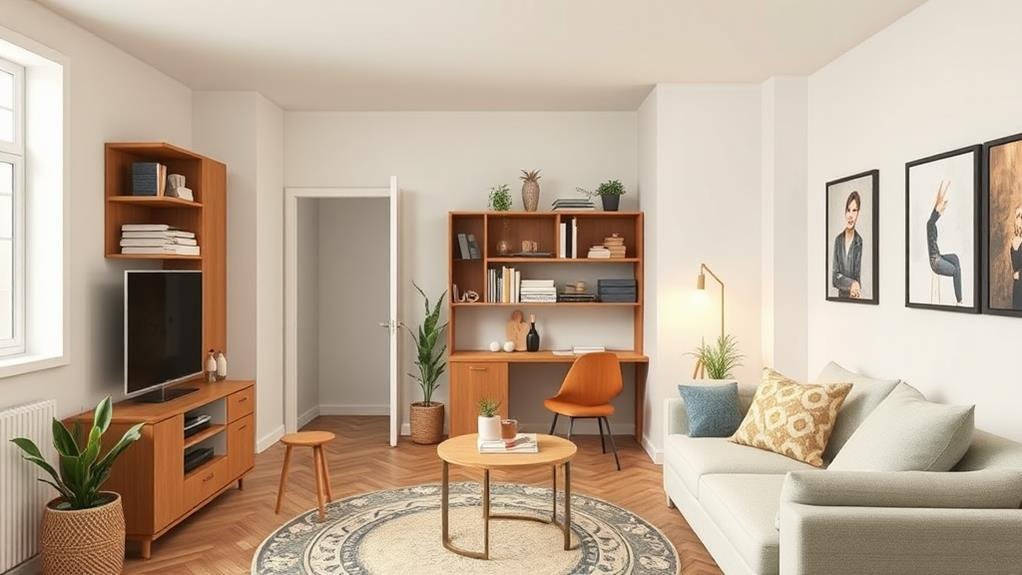
Embracing the challenge of designing small spaces necessitates a keen eye for maximizing every inch of available area. When approaching the design of a compact room, consider the following:
- Multi-Functional Furniture: Opt for pieces that serve more than one purpose, like a storage ottoman or a bed with built-in drawers.
- Vertical Gardening: Utilize wall space for plants to add a touch of nature and freshness without taking up floor space.
- Minimalistic Decor: Embrace simplicity to avoid clutter, making the room feel more spacious and airy.
- Open Shelving: Display items on open shelves to create an illusion of more space and keep things organized.
Incorporating these space-saving solutions can greatly enhance the functionality and aesthetic appeal of small interiors.
Remember to pay attention to color psychology, utilize acoustic treatment for noise reduction, maximize natural light, ensure a smooth spatial flow, and strategically place decorative mirrors to create the illusion of a larger space.
Mixing Modern and Traditional Styles
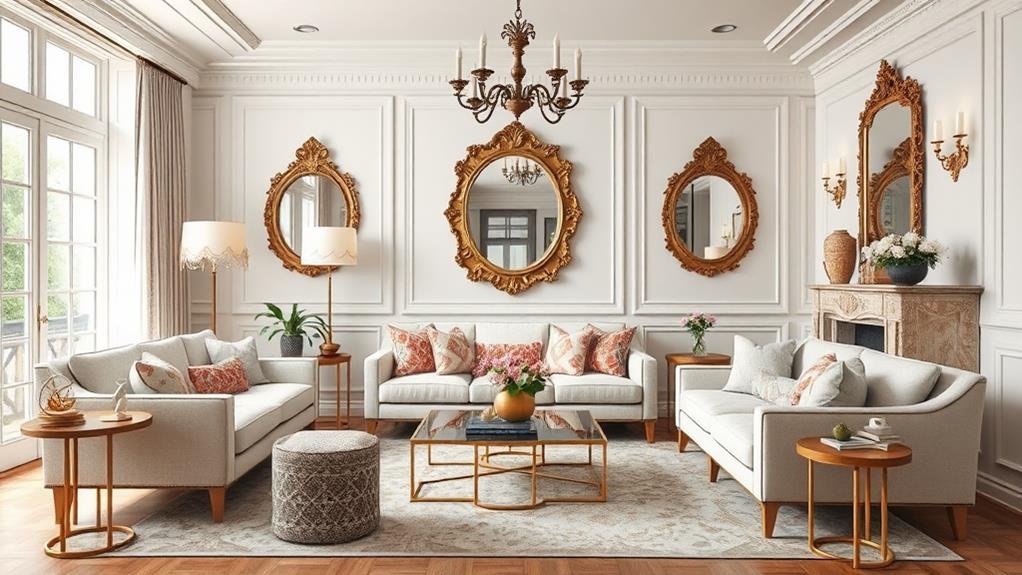
To artfully merge modern and traditional styles in interior design, you're stepping into a realm where old-world charm meets contemporary flair. By blending eclectic combinations of cultural influences and timeless elements, you create aesthetic harmony that allows space to flow seamlessly while expressing your personal style. Incorporating material contrasts and historical references, you navigate the design evolution with functional beauty at its core.
| Elements | Description |
|---|---|
| Eclectic Combinations | Mix and match pieces for a unique look |
| Cultural Influences | Infuse global essences into your space |
| Timeless Elements | Classic pieces that stand the test of time |
| Aesthetic Harmony | Balance and cohesion in your design |
| Space Flow | Ensuring a seamless transition between areas |
In mastering the fusion of modern and traditional styles, you open a world of possibilities where design speaks volumes about your taste and appreciation for the beauty in contrast and continuity alike.
Embracing Sustainable Design Practices
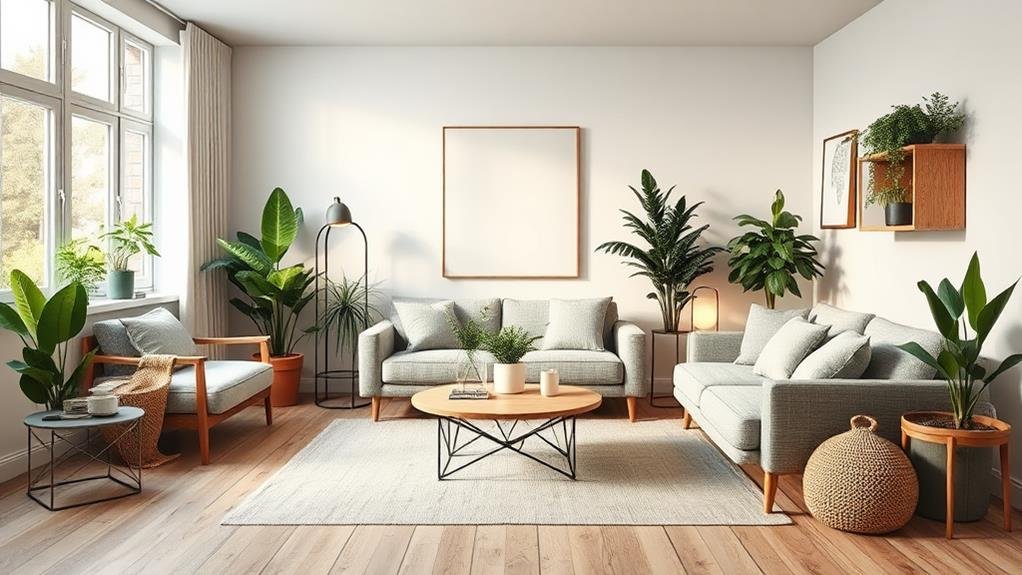
Welcome to the realm of sustainable design practices, where your choices hold the power to make a lasting impact.
Embrace eco-friendly materials that not only elevate the aesthetic of your space but also reduce your carbon footprint.
Pair these with efficient energy usage techniques to create a harmonious blend of style and sustainability in your interior design endeavors.
Eco-friendly Material Choices
Considering the importance of sustainable design practices in today's interior design landscape, the careful selection of eco-friendly materials is paramount.
When it comes to eco-friendly material choices, there are several options available to create a beautiful and sustainable living space:
- Recycled textiles: Utilizing fabrics created from recycled materials can add a unique touch to your interior design while reducing waste.
- Biodegradable materials: Opt for materials that break down naturally, helping to minimize environmental impact.
- Sustainable sourcing: Choose materials that are responsibly and ethically sourced to support eco-conscious practices.
- Eco-friendly paints: Select paints with low VOC options to improve indoor air quality and reduce harmful emissions.
Efficient Energy Usage
Embracing sustainable design practices involves optimizing energy usage to create more environmentally friendly and cost-efficient interior spaces. When it comes to interior design, incorporating energy-efficient appliances and smart home technology can significantly reduce energy consumption. Utilizing renewable energy sources like solar panels complements the design, providing clean energy while cutting down on utility costs. Energy conservation techniques such as implementing passive solar design and effective thermal insulation strategies enhance the overall energy efficiency of a space. By integrating these elements into your interior design projects, you can minimize your environmental impact and create spaces that are both stylish and sustainable.
| Energy Efficient Appliances | Smart Home Technology |
|---|---|
| – ENERGY STAR rated | – Automated lighting systems |
| – Low energy consumption | – Smart thermostats |
| – Water-saving features | – Remote monitoring capabilities |
Utilizing these technologies not only benefits the environment but also adds a modern and sophisticated touch to your design projects.
Mastering the Art of Styling
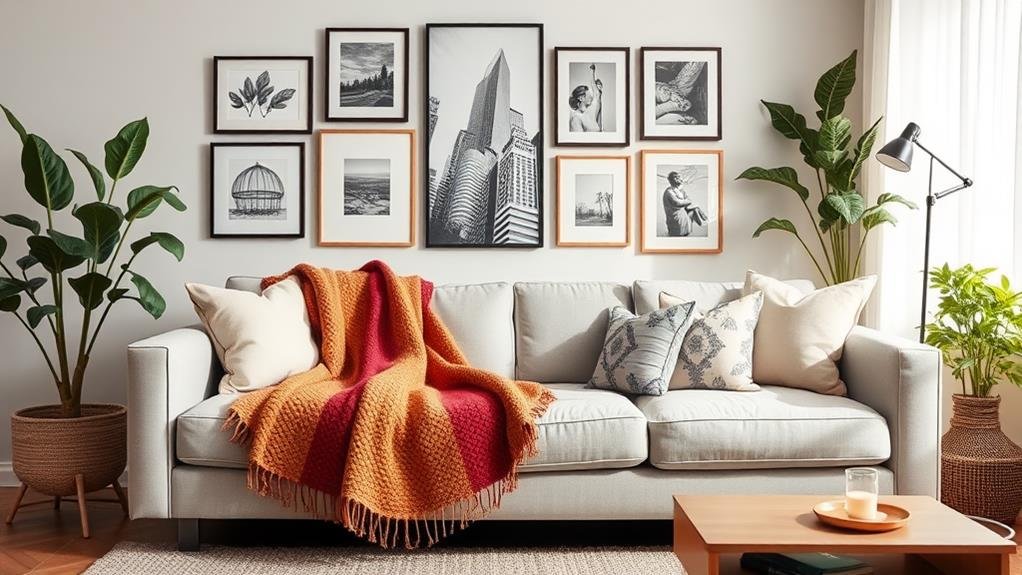
With meticulous attention to detail, mastering the art of styling can elevate the overall aesthetics of an interior space to new heights. Staying attuned to current decor trends and understanding color psychology are essential for creating a harmonious atmosphere.
Art placement plays a crucial role in defining the focal points within a room, while ensuring spatial flow for a seamless look. Seasonal updates offer an opportunity to infuse fresh energy, catering to diverse cultural influences that can enrich the design.
- Experiment with various styling techniques to find what resonates with your personal taste.
- Embrace a minimalism approach to create a clean and uncluttered environment.
- Explore layering styles to add depth and dimension to your decor.
- Implement accessorizing tips to bring personality and charm to your space.
Conclusion
Congratulations, you've now mastered the art of interior design! Just remember, it's not about following the rules, but breaking them with style. So go ahead, mix those patterns, clash those colors, and embrace your inner design rebel. Your home is your canvas, so paint it with confidence and flair. And always remember, a little bit of sass and a touch of class go a long way in creating the perfect interior space. Happy decorating!

